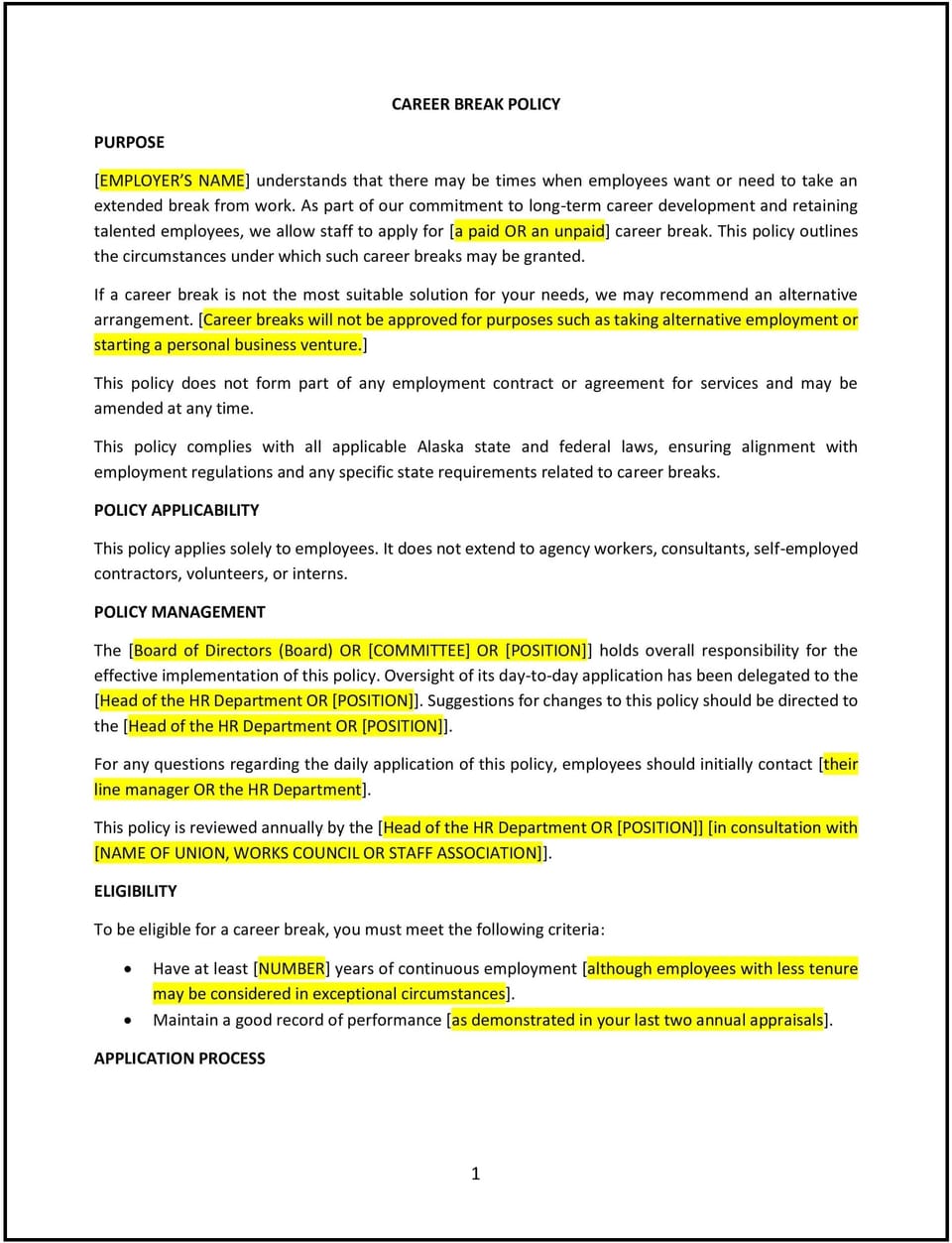Career break policy (Alaska): Free template

Career break policy (Alaska)
In Alaska, a career break policy allows employees to take extended unpaid leave for personal development, caregiving, travel, or other significant life events while maintaining a connection to their employer. This policy outlines eligibility criteria, application procedures, and expectations during and after the break. By implementing a career break policy, businesses can demonstrate flexibility and support for employees' work-life balance, fostering loyalty and long-term engagement.
Alaska's unique workforce dynamics, including seasonal industries and remote work arrangements, may require tailoring the policy to address specific challenges, such as maintaining continuity during peak seasons or accommodating remote employees.
How to use this career break policy (Alaska)
- Define eligibility: Clearly outline who is eligible for a career break, such as employees with a specific tenure or in certain roles. This ensures fairness and consistency in how the policy is applied.
- Establish application procedures: Specify how employees can request a career break, including the required notice period, documentation, and approval process.
- Set clear expectations: Detail the terms of the career break, such as its duration, whether benefits will continue, and the employee's responsibilities for maintaining communication during the break.
- Plan for reintegration: Outline how employees will be reintegrated into the workforce after their career break, including potential adjustments to their roles or responsibilities.
- Communicate limitations: Clearly state that approval of career breaks is subject to business needs, and some requests may be deferred or denied based on operational requirements.
Benefits of using a career break policy (Alaska)
A career break policy provides multiple advantages for businesses and employees in Alaska. Here’s how it helps:
- Encourages retention: Demonstrates flexibility and support for employees’ personal goals, encouraging them to return after their break.
- Enhances morale: Shows employees that the company values their well-being and understands the importance of work-life balance.
- Maintains workforce continuity: By allowing planned breaks, the policy helps businesses prepare for temporary staffing adjustments rather than unexpected resignations.
- Supports compliance: Helps businesses structure leave arrangements in a way that supports compliance with applicable labor laws.
- Builds employer reputation: Positions the company as an employee-focused organization, which can attract top talent and improve overall recruitment efforts.
Tips for using a career break policy (Alaska)
- Be transparent: Clearly communicate how the policy works and ensure employees understand the terms before requesting a career break.
- Plan for coverage: Develop strategies to manage workloads during career breaks, such as temporary hires, cross-training, or reallocating tasks among team members.
- Address seasonal challenges: For industries with seasonal peaks, specify how career breaks will be managed during critical periods to avoid disruptions.
- Monitor impact: Regularly review the policy’s effectiveness and make adjustments as needed to balance employee needs with business operations.
- Provide reintegration support: Offer resources, such as training or counseling, to help employees transition back into the workplace after their career break.
Q: How do I decide if an employee's career break request should be approved?
A: Consider factors such as business needs, the timing of the request, and the employee's role. If the break would significantly disrupt operations, you may need to discuss alternative arrangements or defer the request.
Q: What should I include in the policy regarding benefits during a career break?
A: Clearly state which benefits, if any, will continue during the break, such as health insurance, and outline whether employees need to contribute to maintain coverage. This ensures transparency and consistency.
Q: How can I manage workloads during an employee's career break?
A: Plan ahead by cross-training team members, hiring temporary staff, or redistributing responsibilities within the team. This minimizes disruptions and ensures continuity.
Q: Is there a risk that employees won’t return after a career break?
A: While career breaks encourage retention, it’s important to include terms in the policy that clarify expectations for returning to work and outline procedures if an employee decides not to return.
Q: What steps should I take to reintegrate employees after a career break?
A: Provide resources like role-specific training, a re-onboarding process, or flexible adjustments to ease their transition back into the workplace.
This article contains general legal information and does not contain legal advice. Cobrief is not a law firm or a substitute for an attorney or law firm. The law is complex and changes often. For legal advice, please ask a lawyer.


